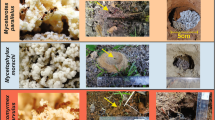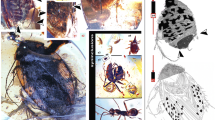Abstract
Fungus-farming “attine” ant agriculture consists of five distinct agricultural systems characterized by a remarkable symbiont fidelity in which five phylogenetic groups of ants faithfully cultivate five phylogenetic groups of fungi. Across-system garden switching experiments result in colony decline and death, indicating that attine ant-fungus symbiont fidelity is enforced by poorly understood biological constraints. The most dramatic violation of this pattern of symbiont fidelity occurs in the relict species Apterostigma megacephala, the only lower-attine ant known to cultivate a higher-attine fungus. Apterostigma megacephala is the sole surviving representative of an ancient lineage that diverged from all other Apterostigma fungus-farming ants ~39 million years ago, yet it cultivates Leucoagaricus gongylophorus, a highly domesticated fungal species that originated in the gardens of the recently evolved leaf-cutting ants 8–11 million years ago. Understanding the biology of A. megacephala, therefore, may provide important clues about the biological mechanisms that constrain the otherwise seemingly obligate ant-fungus associations that characterize attine ant agriculture. Here, based on field work in the Floresta Nacional de Carajás in the state of Pará in Brazil, we report the previously unknown biology of A. megacephala, including nest architecture, colony demography, foraging behavior, and the morphologies of the previously undescribed gyne, male, and larva.









Similar content being viewed by others
References
Aylward FO, Burnum-Johnson KE, Tringe SG, Teiling C, Tremmel DM, Moeller JA, Scott JJ, Barry KW, Piehowski PD, Nicora CD, Malfatti SA, Monroe ME, Purvine SO, Goodwin LA, Smith RD, Weinstock GM, Gerardo NM, Suen G, Lipton MS, Currie CR (2013) Leucoagaricus gongylophorus produces diverse enzymes for the degradation of recalcitrant plant polymers in leaf-cutter ant fungus gardens. Appl Environ Microb 79:3770–3778. doi:10.1128/AEM.03833-12
Cordani UG, Teixeira W, D’Agrella-Filho MS, Trindade RI (2009) The position of the Amazonian Craton in supercontinents. Gondwana Res 15:396–407. doi:10.1016/j.gr.2008.12.005
De Fine Licht HH, Boomsma JJ, Tunlid A (2014) Symbiotic adaptations in the fungal cultivar of leaf-cutting ants. Nat Commun 5:5675–5675. doi:10.1038/ncomms6675
De Fine Licht HH, Schiøtt MM, Rogowska-Wrzesinska A, Nygaard SS, Roepstorff PP, Boomsma JJ (2013) Laccase detoxification mediates the nutritional alliance between leaf-cutting ants and fungus-garden symbionts. Proc Natl Acad Sci USA 110:583–587. doi:10.1073/pnas.1212709110
Gauld I, Bolton B (1988) The Hymenoptera. Oxford University Press in association with British Museum (Natural History)
Gumier-Costa F, Sperber CF (2009) Atropelamentos de vertebrados na Floresta Nacional de Carajás, Pará, Brasil. Acta Amaz 39:1–10
Jesovnik A, González VL, Schultz TR (2016) Phylogenomics and divergence dating of fungus-farming ants (Hymenoptera: Formicidae) of the genera Sericomyrmex and Apterostigma. PLoS ONE 11:e0151059. doi:10.1371/journal.pone.0151059
Jesovnik A, Sosa-Calvo J, Lopes CT, Vasconcelos HL, Schultz TR (2013) Nest architecture, fungus gardens, queen, males, and larvae of the fungus-growing ant Mycetagroicus inflatus Brandão & Mayhé-Nunes. Insect Soc 60:531–542. doi:10.1007/s00040-013-0320-8
Klingenberg C, Brandão CRF (2009) Revision of the fungus-growing ant genera Mycetophylax Emery and Paramycetophylax Kusnezov rev. stat., and description of Kalathomyrmex n. gen. (Formicidae: Myrmicinae: Attini). Zootaxa 2052:1–31
Kooij PW, Aanen DK, Schiøtt M, Boomsma JJ (2015) Evolutionarily advanced ant farmers rear polyploid fungal crops. J Evol Biol 28:1911–1924. doi:10.1111/jeb.12718
Lattke JE (1999) A new species of fungus-growing ant and its implications for attine phylogeny (Hymenoptera: Formicidae). Syst Entomol 24:1–6
Lopes JFS, Hughes WOH, Camargo RS, Forti LC (2005) Larval isolation and brood care in Acromyrmex leaf-cutting ants. Insect Soc 52:333–338. doi:10.1007/s00040-005-0816-y
Masiulionis VE, Rabeling C, De Fine Licht HH, Schultz T, Bacci M, Bezerra CMS, Pagnocca FC (2014) A Brazilian population of the asexual fungus-growing ant Mycocepurus smithii (Formicidae, Myrmicinae, Attini) cultivates fungal symbionts with gongylidia-like structures. PLoS ONE 9:e103800. doi:10.1371/journal.pone.0103800
Mehdiabadi NJ, Mueller UG, Brady SG, Himler AG, Schultz TR (2012) Symbiont fidelity and the origin of species in fungus-growing ants. Nat Commun 3:840–840. doi:10.1038/ncomms1844
Mikheyev AS, Mueller UG, Abbot P (2010) Comparative dating of attine ant and lepiotaceous cultivar phylogenies reveals coevolutionary synchrony and discord. Am Nat 175:E126–E133. doi:10.1086/652472
Mikheyev AS, Mueller UG, Boomsma JJ (2007) Population genetic signatures of diffuse co-evolution between leaf-cutting ants and their cultivar fungi. Mol Ecol 16:209–216. doi:10.1111/j.1365-294X.2006.03134.x
Mikheyev AS, Vo T, Mueller UG (2008) Phylogeography of post-Pleistocene population expansion in a fungus-gardening ant and its microbial mutualists. Mol Ecol 17:4480–4488. doi:10.1111/j.1365-294X.2008.03940.x
Mueller UG, Rehner SA, Schultz TR (1998) The evolution of agriculture in ants. Science 281:2034–2038. doi:10.1126/science.281.5385.2034
Mueller UG, Schultz TR, Currie C, Adams RMM, Malloch D (2001) The origin of the attine ant-fungus mutualism. Q Rev Biol 76:169–197
Nygaard S, Hu H, Li C, Schiøtt M, Chen Z, Yang Z, Xie Q, Ma C, Deng Y, Dikow RB, Rabeling C, Nash DR, Wcislo WT, Brady SG, Schultz TR, Zhang G, Boomsma JJ (2016) Reciprocal genomic evolution in the ant-fungus agricultural symbiosis. Nat Commun 7:12233. doi:10.1038/ncomms12233
Nygaard S, Zhang G, Schiøtt M, Li C, Wurm Y, Hu H, Zhou J, Ji L, Qiu F, Rasmussen M (2011) The genome of the leaf-cutting ant Acromyrmex echinatior suggests key adaptations to advanced social life and fungus farming. Genome Res 21:1339–1348. doi:10.1101/gr.121392.111
Rabeling C, Bacci M (2010) A new workerless inquiline in the Lower Attini (Hymenoptera: Formicidae), with a discussion of social parasitism in fungus-growing ants. Syst Entomol 35:379–392. doi:10.1111/j.1365-3113.2010.00533.x
Rabeling C, Cover SP, Johnson RA, Mueller UG (2007a) A review of the North American species of the fungus-gardening ant genus Trachymyrmex (Hymenoptera: Formicidae). Zootaxa 1664:1–53
Rabeling C, Gonzales O, Schultz TR, Bacci M Jr, Garcia MVB, Verhaagh M, Ishak HD, Mueller UG (2011) Cryptic sexual populations account for genetic diversity and ecological success in a widely distributed, asexual fungus-growing ant. Proc Natl Acad Sci USA 108:12366–12371. doi:10.1073/pnas.1105467108
Rabeling C, Schultz TR, Bacci M Jr, Bollazzi M (2015) Acromyrmex charruanus: a new inquiline social parasite species of leaf-cutting ants. Insect Soc 62:335–349. doi:10.1007/s00040-015-0406-6
Rabeling C, Verhaagh M, Engels W (2007b) Comparative study of nest architecture and colony structure of the fungus-growing ants, Mycocepurus goeldii and M. smithii. J Insect Sci 7:1–13. doi:10.1673/031.007.4001
Schneider M, Bueno OC, Hebling MJA, Pagnocca FC (2000) Observations on brood care behaviour of the leafcutting ant Atta sexdens L. (Hymenoptera: Formicidae). In: XXI international congress of entomology, pp 20–26
Schultz TR, Meier R (1995) A phylogenetic analysis of the fungus-growing ants (Hymenoptera: Formicidae: Attini) based on morphological characters of the larvae. Syst Entomol 20:337–370. doi:10.1111/j.1365-3113.1995.tb00100.x
Schultz TR (1993) Stalking the wild attine. Notes Undergr 8:7–10
Schultz TR (2007) The fungus-growing ant genus Apterostigma in Dominican amber. Mem Am Entomol Soc 80:425–436
Schultz TR, Brady SG (2008) Major evolutionary transitions in ant agriculture. Proc Natl Acad Sci USA 105:5435–5440. doi:10.1073/pnas.0711024105
Schultz TR, Sosa-Calvo J, Brady SG, Lopes CT, Mueller UG, Bacci M Jr, Vasconcelos HL (2015) The most relictual fungus-farming ant species cultivates the most recently evolved and highly domesticated fungal symbiont species. Am Nat 185:693–703. doi:10.1086/680501
Seal JN, Gus J, Mueller UG (2012) Fungus-gardening ants prefer native fungal species: do ants control their crops? Behav Ecol 23:1250–1256. doi:10.1093/beheco/ars109
Seal JN, Mueller UG (2014) Instability of novel ant-fungal associations constrains horizontal exchange of fungal symbionts. Evol Ecol 28:157–176. doi:10.1007/s10682-013-9665
Serna F, Mackay W (2010) A descriptive morphology of the ant genus Procryptocerus (Hymenoptera: Formicidae). J Insect Sci 10:111. doi:10.1673/031.010.11101
Sosa-Calvo J, Jesovnik A, Okonski E, Schultz TR (2015) Locating, collecting, and maintaining colonies of fungus-farming ants (Hymenoptera: Myrmicinae: Attini). Sociobiology 62:300–320. doi:10.13102/sociobiology.v62i2.300-320
Sosa-Calvo J, Schultz TR (2010) Three remarkable new fungus-growing ant species of the genus Myrmicocrypta (Hymenoptera: Formicidae), with a reassessment of the characters that define the genus and its position within the Attini. Ann Entomol Soc Am 103:181–195. doi:10.1603/AN09108
Sosa-Calvo J, Schultz TR, Brandão CRF, Klingenberg C, Feitosa RM, Rabeling C, Bacci M Jr, Lopes CT, Vasconcelos HL (2013) Cyatta abscondita: Taxonomy, evolution, and natural history of a new fungus-farming ant genus from Brazil. PLoS ONE 8:e80498. doi:10.1371/journal.pone.0080498
Suen G, Teiling C, Li L, Holt C, Abouheif E, Bornberg-Bauer E, Bouffard P, Caldera EJ, Cash E, Cavanaugh A (2011) The genome sequence of the leaf-cutter ant Atta cephalotes reveals insights into its obligate symbiotic lifestyle. PLoS Genet 7:e1002007. doi:10.1371/journal.pgen.1002007
Teixeira JBG, Misi A, da Glória da Silva M (2007) Supercontinent evolution and the Proterozoic metallogeny of South America. Gondwana Res 11:346–361. doi:10.1016/j.gr.2006.05.009
Trendall AF, Basei MAS, De Laeter JR, Nelson DR (1998) SHRIMP zircon U–Pb constraints on the age of the Carajás formation, Grão Pará Group, Amazon Craton. J S Am Earth Sci 11:265–277. doi:10.1016/S0895-9811(98)00015-7
Ward PS, Brady SG, Fisher BL, Schultz TR (2015) The evolution of myrmicine ants: phylogeny and biogeography of a hyperdiverse ant clade (Hymenoptera: Formicidae). Syst Entomol 40:61–81. doi:10.1111/syen.12090
Wheeler GC, Wheeler J (1976) Ant larvae: Review and synthesis. Mem Entomol Soc Wash 7:1–108
Wilson EO (1971) The insect societies. The insect societies. Belknap Press, Cambridge
Acknowledgements
We are grateful to R. C. F. Brandão and R. Rosa da Silva for information about Apterostigma megacephala in Carajás; to T. Izzo for information about A. megacephala in Juara, Mato Grosso; to J. Chaúl (Universidade Federal de Viçosa) for information regarding collections of A. megacephala in Canarana, Mato Grosso; to F. Drumond Martins and E. Esteves of Instituto Chico Mendes de Conservação da Biodiversidade (ICMBio) at Floresta Nacional de Carajás for their help and guidance; to E. Okonski (NMNH) for collections and research support; to S. Messer (University of Rochester) for help with the description of the male genitalia, and to S. Whittaker (NMNH) for help with preparation of the larvae. This manuscript was greatly improved thanks to comments from Terry McGlynn and two anonymous reviewers. For permission to conduct field research, we thank the Conselho Nacional de Desenvolvimento Científico e Tecnológico (CNPq; Processo EXC 039/07; Portarias 267, 359), the Instituto Brasileiro do Meio Ambiente e dos Recursos Naturais Renováveis (IBAMA), and the ICMBio (permits 14789-1, 14789-2). J. S.-C., C. R., and T. R. S. were supported by National Science Foundation (NSF) Grants (DEB-1456964 and DEB-1654829), T. R. S. and J. S.-C. were supported by National Science Foundation (NSF) Grant DEB-0949689, and the National Museum of Natural History (NMNH) Small Grants program; T. R. S. by the Smithsonian Institution Scholarly Studies Program; J. S.-C. and A. J. by NMNH Peter Buck Predoctoral Fellowships and Max and Vera Britton Environmental Science Awards (Cosmos Club Foundation); and M. B. and A. R. by the Fundação de Amparo à Pesquisa do Estado de São Paulo (FAPESP; 2011/50226-0; 2014/24298-1, respectively) and CNPq (311562/2012-4 and 487639/2012-0).
Author information
Authors and Affiliations
Corresponding author
Rights and permissions
About this article
Cite this article
Sosa-Calvo, J., Ješovnik, A., Lopes, C.T. et al. Biology of the relict fungus-farming ant Apterostigma megacephala Lattke, including descriptions of the male, gyne, and larva. Insect. Soc. 64, 329–346 (2017). https://doi.org/10.1007/s00040-017-0550-2
Received:
Revised:
Accepted:
Published:
Issue Date:
DOI: https://doi.org/10.1007/s00040-017-0550-2




